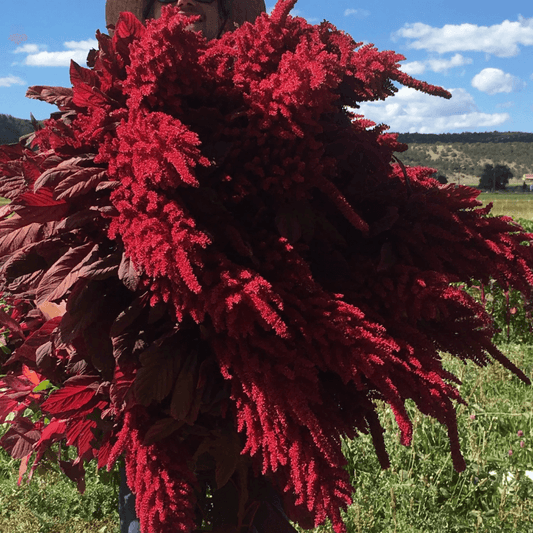Collection: Grow Amaranth Plants From Seed
Amaranth Seeds – A Drought-Tolerant Superfood & Ornamental Beauty
Amaranth (Amaranthus spp.) is a fast-growing, drought-tolerant plant valued for its edible greens and protein-rich seeds. A traditional staple food in many cultures, it produces vibrant flower plumes and thrives in dry conditions, making it ideal for home gardens and permaculture landscapes. Whether you’re growing organic amaranth seeds for leafy greens or dry amaranth grain, this crop is easy to grow. Start amaranth seeds indoors or sow directly outdoors for an early harvest. When harvesting amaranth, collect young leaves or mature seed heads for cooking and storage. Explore high-quality amaranth seeds for sale to grow your own nutrient-dense food at home.
Why Grow Amaranth Seeds?
-
Nutritious & Versatile Superfood – Grain amaranth is a high-protein, gluten-free seed, while the young leaves are packed with vitamins and minerals.
-
Striking Cut Flower & Garden Showpiece – Many amaranth species, including Amaranthus hypochondriacus, produce tall, vibrant flower spikes, making them excellent for cut flower arrangements.
-
Drought-Tolerant & Heat-Resistant – Amaranth thrives in hot, dry climates, making it perfect for water-wise gardening.
-
Dual-Purpose Crop (Food & Soil Improvement) – Acts as both a nutrient-rich food source and a cover crop that enhances soil health.
-
Self-Seeding & Easy to Grow – Once established, amaranth will readily reseed itself, providing continuous harvests year after year.
Ways to Use Amaranth:
-
Harvest Tiny Seeds for Grain Amaranth – Use in porridge, baked goods, soups, or popped like popcorn.
-
Eat as Nutritious Greens – Young amaranth leaves are tender and perfect for salads, sautés, and smoothies.
-
Grow as a Cut Flower – The dramatic, cascading flower spikes make stunning additions to floral arrangements.
-
Improve Soil with a Cover Crop – Helps prevent erosion and enrich the soil with organic matter.
The History & Cultural Importance of Amaranth
Amaranth has been cultivated for over 8,000 years, originating in Mesoamerica and the Andes, where it was a sacred grain for the Aztecs, Mayans, and Incas. Highly valued for its nutritional and ceremonial significance, amaranth remains a staple crop in many parts of the world. Today, grain amaranth and other amaranth species are widely grown for their hardiness, health benefits, and ornamental appeal.
How to Plant Amaranth Seeds:
-
Planting Time: Sow tiny seeds directly outdoors after the last frost or start indoors 6-8 weeks before the last frost for an early harvest.
-
Sun Requirements: Prefers full sun (at least 6-8 hours daily) for best growth.
-
Soil & Watering: Adapts to poor soil conditions but thrives in well-drained soil with moderate watering.
-
Harvesting: Pick young leaves early for greens, or allow flowers to mature and harvest grain amaranth seeds.
Grow Your Own Nutritious & Beautiful Amaranth!
Whether you're looking for a nutrient-packed grain, edible greens, or a striking cut flower, amaranth is an easy-to-grow, drought-tolerant plant that adds beauty and nutrition to any garden. Order high-quality amaranth seeds today and start growing this ancient superfood!
For additional detail, see our recent blog on Amaranth.
